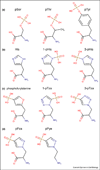pHisphorylation: the emergence of histidine phosphorylation as a reversible regulatory modification
- PMID: 28129587
- PMCID: PMC5482761
- DOI: 10.1016/j.ceb.2016.12.010
pHisphorylation: the emergence of histidine phosphorylation as a reversible regulatory modification
Abstract
Histidine phosphorylation is crucial for prokaryotic signal transduction and as an intermediate for several metabolic enzymes, yet its role in mammalian cells remains largely uncharted. This is primarily caused by difficulties in studying histidine phosphorylation because of the relative instability of phosphohistidine (pHis) and lack of specific antibodies and methods to preserve and detect it. The recent synthesis of stable pHis analogs has enabled development of pHis-specific antibodies and their use has started to shed light onto this important, yet enigmatic posttranslational modification. We are beginning to understand that pHis has broader roles in protein and cellular function including; cell cycle regulation, phagocytosis, regulation of ion channel activity and metal ion coordination. Two mammalian histidine kinases (NME1 and NME2), two pHis phosphatases (PHPT1 and LHPP), and a handful of substrates were previously identified. These new tools have already led to the discovery of an additional phosphatase (PGAM5) and hundreds of putative substrates. New methodologies are also being developed to probe the pHis phosphoproteome and determine functional consequences, including negative ion mode mass spectroscopy and unnatural amino acid incorporation. These new tools and strategies have the potential to overcome the unique challenges that have been holding back our understanding of pHis in cell biology.
Copyright © 2017 Elsevier Ltd. All rights reserved.
Figures


References
-
- Boyer PD, DeLuca M, Ebner KE, Hultquist DE, Peter JE. Identification of phosphohistidine in digests from a probable intermediate of oxidative phosphorylation. J Biol Chem. 1962;237:3306–3308. - PubMed
-
- Attwood PV, Piggott MJ, Zu XL, Besant PG. Focus on phosphohistidine. Amino Acids. 2007;32:145–156. - PubMed
-
-
Fuhs SR, Meisenhelder J, Aslanian A, Ma L, Zagorska A, Stankova M, Binnie A, Al-Obeidi F, Mauger J, Lemke G, et al. Monoclonal 1- and 3-phosphohistidine antibodies: new tools to study histidine phosphorylation. Cell. 2015;162:198–210. This study describes the generation and use of monoclonal antibodies that specifically recongnize either the 1-pHis or 3-pHis isomer. Their characterization and specificity is demonstrated and methods for their use in several immunological assays including immunoblotting, immunofluorescence and immunoaffity purification of pHis proteins and analysis by LC-MS/MS.
-
-
- Matthews HR, Chan K. Protein histidine kinase. Methods Mol Biol. 2001;124:171–182. - PubMed
Publication types
MeSH terms
Substances
Grants and funding
LinkOut - more resources
Full Text Sources
Other Literature Sources
Research Materials
Miscellaneous

